

Rough Notes:
The Craters Are Electric
12/07/2007
By Michael Goodspeed
Suspension of disbelief is a well known mental process whereby a person engaged by a fictional story temporarily surrenders his rational logic. This intensifies a story's emotional impact, particularly when it is too implausible for the intellect to accept. For those engaged in scientific investigation, a similar mental exercise is required in order for one to interpret evidence objectively. Rather than suspend one's logical discernment, one must lay aside all assumptions and biases that might distort or limit one's field of vision. This might be called the suspension of BELIEF(s).
The German philosopher Arthur Schopenhauer once said, "The discovery of truth is prevented more effectively, not by the false appearance things present and which mislead into error, not directly by weakness of the reasoning powers, but by preconceived opinion, by prejudice." The most fundamental "prejudice" that has directed the space sciences for decades is the belief that space is electrically inert. Throughout the Space Age, every new discovery has been interpreted through a lens that views gravity and gravity alone as the force that shapes the heavens.
When the first space probes returned images of the Moon, they revealed a surface heavily pockmarked with craters and riddled with long-sinuous channels (or rilles). Scientists seeking to interpret these features were constrained by the traditional geologic toolkit. The "debate" over the lunar craters only included two possible causative agents: volcanism, or impact. Eventually, a consensus was reached that meteoric impacts were the primary source of lunar craters.
But more than forty years ago, the British journal Spaceflight published the laboratory experiments of Brian J. Ford, an amateur astronomer who raised the possibility that most of the craters on the moon were carved by cosmic electrical discharge. (Spaceflight 7, January, 1965).
In the cited experiments Ford used a spark-machining apparatus to reproduce in miniature some of the most puzzling lunar features, including craters with central peaks, small craters preferentially perched on the high rims of larger craters, and craters strung out in long chains. He also observed that the ratio of large to small craters on the Moon matched the ratio seen in electrical arcing.
Unfortunately (but not surprisingly), no one in the scientific mainstream followed up on Ford's investigation. To consider an electric source to the lunar craters, scientists would have to entertain electrical discharge events more energetic than anything they could envision. The notion of planetary instability and violent electric arcing between planets and moons is totally incompatible with most everything astronomers believe about space physics and celestial mechanics.
Ironically, even as astronomers codified the electrically neutral solar system, the leading pioneers of plasma science were observing stupendous electric forces in space, and documenting the analogs in laboratory discharge phenomena. The father of plasma science, Hannes Alfven, when receiving the Noble prize in physics in 1970, admonished astronomers and cosmologists for ignoring the role of electric currents in the evolution of cosmic bodies.
But when considering planetary history, astronomers are handicapped in two ways: 1) For reasons that are perfectly understandable, they assume that the present serenity and predictable movements of planets and moons can be projected backwards indefinitely. 2) Since most have little or no training in electrodynamics and plasma discharge, their concepts of electricity in space are limited to elementary electrostatics and magnetism, a weakness that has fostered great confusion in the space sciences. They cannot imagine how the inert "vacuum" of space could give rise to the high-energy events investigated in specialized plasma discharge experiments.
For today's electrical theorists, no small adjustment to perception will suffice. A sweeping revision is necessary, one that recognizes the predictable effect when a charged planet or moon moves through an electrified plasma. Where field strength is high, the result will be global electric discharge, as cosmic "thunderbolts" rake across the surface, creating entirely new topography.
Allow this possibility, and the exploration of solar system history is radically altered. Suddenly, plasma discharge and electrical arcing experiments (which have been excluded from planetary science) will be permitted to shed their light on thousands of features left unexplained by traditional theory.
On every solid body in space, we have observed craters lacking any conventional explanation. In fact, on close observation, many craters show distinct features that are not associated with volcanic or impact craters, but are easily created by electric arcs in the laboratory and by electric discharge machining (EDM) used in industrial applications.
Craters in the laboratory

In laboratory experiments using electric arcs, plasma physicist C. J. Ransom produced the craters in the above photo. This cratered surface duplicates many characteristics of planetary geology. The craters tend to clump according to size, and to fall in lines and arcs. Notice also that the ground appears burnt or discolored where the discharge was strongest and the craters the densest -- not unlike the surface of Mars and other rocky bodies in the solar system. The centers of some of the craters have bumps, as do many enigmatic craters on the Moon, Mars, and other surfaces. Also of interest are the dark streaks from two larger craters close to the center of the picture, a pattern similar to the "wind"-streaked craters found on Mars.
The similarity between craters on cosmic bodies and craters in the lab does not prove that the craters seen in space were created by electric arcs. But it is a very good reason to not exclude that possibility. In other words, it is only reasonable to examine cratering patterns more carefully. It is indeed ironic that, as NASA spends billions of tax dollars each year, seeking to unravel the mysteries of planetary surfaces, individuals with no NASA connections (or funds!), have begun to explore electrical explanations.
The shallow craters in Dr. Ransom's experiments above have interesting parallels in cratering experiments undertaken by Zane Parker, using nothing more than dust on an electrified CRT screen. The image below, showing shallow craters with accumulation at the rim and highlighted centers is just one of several promising research directions opened up by his simple experiments.
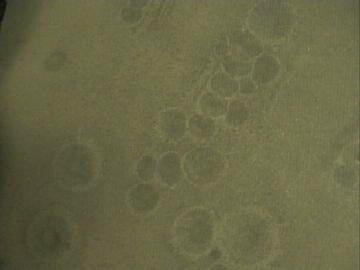
On hearing of Parker's work, James St. Pe experimented with the dust collector on an ionic breeze air purifier, finding that static discharge produced both sharply defined craters either "randomly" distributed or in linear chains, depending on conditions. (See discussion of crater chains and rilles below).
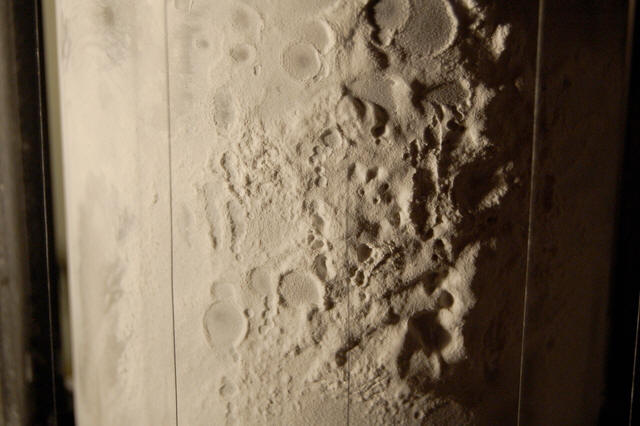
Hexagonal Craters
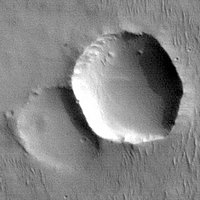
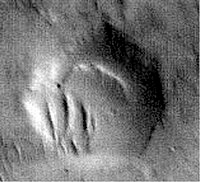
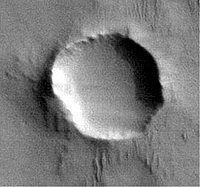
It goes without saying that hexagonal cratering patterns are difficult, if not impossible, to explain with the impact hypothesis. And incredibly, many dozens of such formations have been imaged on planetary surfaces. Above, you see just three of the many observed on Mars (a comprehensive collection can be viewed here ). The unique morphology is of special interest, because it links directly to experimental work with plasma discharge in the laboratory. In recent years, plasma scientists have observed hexagonal patterns in a dielectric barrier discharge streamer (see Lifang Dong et al 2004 Plasma Sources Sci. Technol. 13 164-165 doi:10.1088/0963-0252/13/1/021).
The significance of these experiments is underscored by the fact that studies of impacts have never suggested any kinetic force that might generate such a hexagonal pattern.
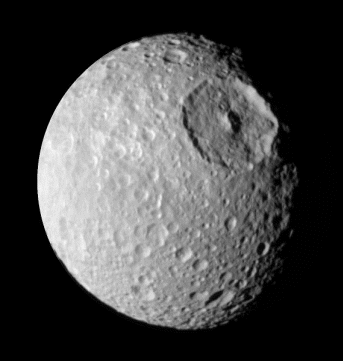
It must be emphasized that the mystery of hexagonal craters extends well beyond the Martian surface. Above, we see Saturn’s tiny moon Mimas dominated by a giant hexagonal crater, also with the telltale central “bump” typical of so many electric discharge craters.
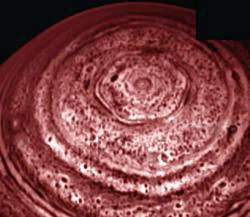
Also of interest, in electrical terms, is the “bizarre” atmospheric hexagon encircling Saturn’s north pole. In this regard, scientists have connected the hexagon to experiments in which the rotational motion of fluids in a cylinder gives rise to a hexagonal form. Rotational motion is characteristic of an electric discharge as well, but would have no plausible link to the mechanics of impact cratering.
Craters With "Twin Peaks"
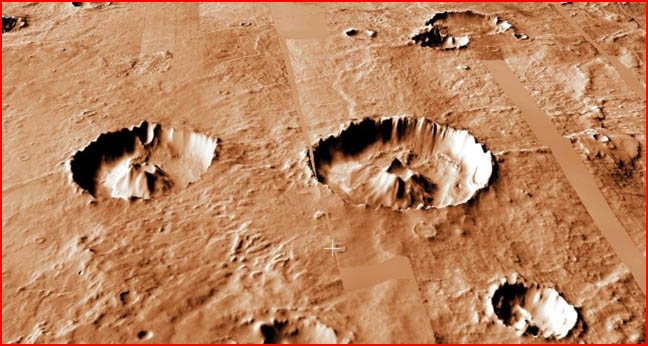
The image above -- provided by Michael Gmirkin and NASA's World Wind 3D software -- shows two dominating Martian craters that share "inconceivable" similarities. These supposed "impact" craters are placed side by side, both with central peaks terminating in CRATERS.
Although the 3D visualization exaggerates depth, the impact hypothesis faces apparently insurmountable difficulties. No formative process envisioned by planetary science ever anticipated central peaks of craters terminating in a second crater, as seen above. The craters are found in a region of Mars that planetary scientists believe to be dominated by "impacts." But the impact theory seems totally unable to account for the forms seen here.
Scientists have been able to produce clumpy "rebound" elevations in explosion craters. They also have a theoretical "analogy" in the rebound effect that occurs in thick fluids into which an object is dropped. But they have no reasonable analog for the steep peaks witnessed above, and the idea of two secondary impacts striking these peaks head-on is simply beyond belief. It should be obvious, therefore, that the presence of two craters exhibiting the same anomaly, and standing side-by-side, categorically excludes the impact hypothesis.
Electrical discharge experiments readily produce craters with central peaks. So it is not a stretch to envision a discharge event excavating the kind of craters seen above, including the pinnacles in their centers. More specifically, electrical theorist Wallace Thornhill envisions twin Birkeland filaments rotating "like a corkscrew around a center" to create these "dished" peaks in the same process that formed the crater. He likens the symmetrically shaped "bowl" at the top of the peaks to the levees created by electrical arcs when they move across the surface to carve out channels or rilles.
"Bulls-eye" Craters
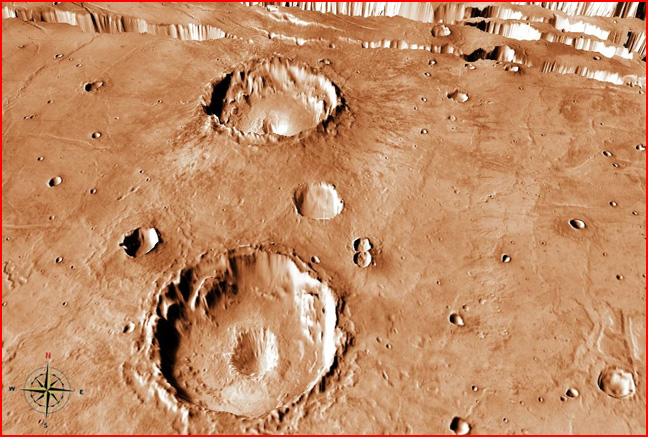
The two craters in the above image show all of the features one expects of depressions cut by electric discharge: typical flat floors, steep sides, pinched up rims, and terraces around their walls. But instead of central peaks, they have central CRATERS. Two more craters that are similar lie to the southwest.
Thunderbolts colleague Michael Gmirkin, in pointing out these craters, has labeled them "bull's eye craters," in reference to the middle concentric circles of a dart board, emphasizing the difficulty of hitting the precise center consistently.
Under the impact interpretation, central craters could only be caused by a second impact that coincidentally struck exactly in the center of the previous impact. The impactors that created the craters would have to hit a perfect "bull's eye" to create this effect. It might happen once. Twice in close proximity is extremely unlikely. But four times in the same neighborhood stretches the meaning of "coincidental" beyond the covers of the dictionary!!
If the arcs that machined the large craters persisted until they pinched down into a very small diameter, or if a second return stroke followed the ionized path left by the first and persisted long enough, the central peaks (if they were not already machined away) would have been "drilled down," perhaps even to a depth below the original craters' floors. Such an event would not be the norm, but several "bull's-eye craters" in a particular area would not be surprising. It may be significant that the four examples noted here lie on the plain just south of Valles Marineris -- seen by the electric theorists as the largest EDM channel (from a traveling arc) in the Solar system.
Rampart Craters
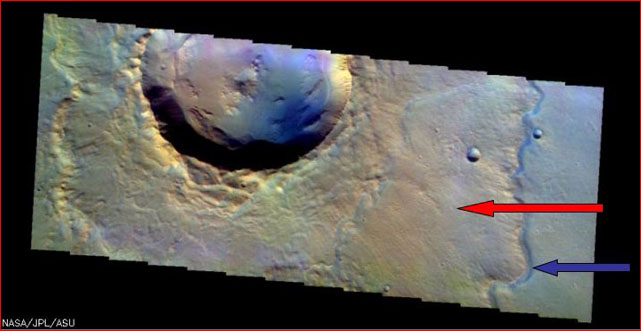
"Rampart" craters and "pedestal" craters on Mars are virtually impossible to explain with the impact model. Pedestal craters, including their bottoms, stand ABOVE the elevation of the surrounding terrain. Rampart craters, like the one shown in the above THEMIS image, are surrounded by a "moat" (red arrow) that's deeper than the original ground level and an outer "rampart" (blue arrow) that's higher than both the moat and the surrounding terrain. The outer rampart seems to have "flowed" away from the crater, rather than to have been ejected.
From an Electric Universe point of view, these craters are enormous "fulgamites," raised blisters like those found on the metal caps of lightning arrestors after a lightning strike. Because the whole blister is lifted above the surface by the lightning arc, the crater at the top is not necessarily deeper than the elevation of the original surface around it. The material forming the raised fulgamite is scavenged from the surroundings, leaving a "moat" below the surface level.
The radial flow features have been produced in the laboratory when an arc strikes a moist clay surface. The arc appears to draw water to the surface and then to drive it away from the crater, generating a distinctive flow pattern. Thus, the rampart craters, combined with laboratory experiments, add to the evidence that Mars had water in the past.
Domed Craters
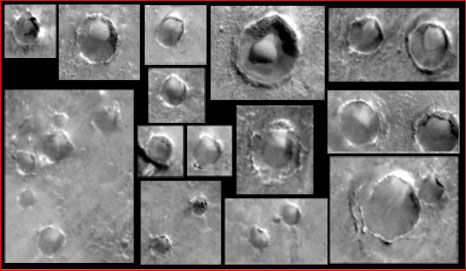

The top images above show large craters on Mars that contain mysterious spherical domes. The bottom images show spheres and craters in Dr. C. J. Ransom's electrical discharge experiments.
Dr. Ransom was compelled to explore a possible electric explanation to the Martian "blueberries" -- tiny, bb-like spherules embedded by the trillions in the Martian surface. He obtained a quantity of hematite -- an iron-rich material that is the primary constituent of the soil surrounding the blueberries -- and blasted it with an electric arc. The embedded spheres created by the arc appear to replicate the features of the blueberries on Mars.
Dr. Ransom's experiments have profound ramifications for our understanding of Mars. In simple appearance, the embedded spheres created by Ransom also look surprisingly similar to the enormous Martian craters and "domes" in the top pictures above. This is significant because of the well-known SCALABILITY of electric discharge -- what occurs on a small scale also occurs on larger scales. In contrast to the rover "blueberry" images, the "domed craters" on Mars range in size from kilometers in diameter down to a hundred meters or less.
At the present time, Ransom's electrical discharge experiments have provided the only fact-based explanation for these anomalous formations. It must be asked, therefore, if the "blueberries" and the domed craters were produced by the same electrical force, acting on widely different scales.
Amazingly, NASA images at the south polar region of Mars have revealed even larger domed craters, as seen here. The area surrounding the ice cap is peppered with craters, many of them several kilometers in diameter, most notably, the formation in the upper left that exhibits a dome-shaped central feature within a crater. It should go without saying that there is no known geologic process producing such features.
Aligned Craters

Above is an image of three aligned craters in the Noachis Terra region on Mars. In interpreting these craters, NASA follows the accepted impact theory: "[T]hree aligned meteor impact craters on the floor of a much larger crater in the Noachis Terra region. The craters may have formed together from a single event in which the impactor (the meteor) was broken into three pieces."
A single event is required because there is no rubble on the floors of the craters from adjacent impacts. The blast force would have had to act simultaneously to displace laterally the ejecta situated between the impacts. But the only imaginable way to get three craters in a single event is to have the impactor break into three pieces. And then the problem returns to the first observation of three ALIGNED craters: It's unlikely that a meteor breaking up under the forces of heat and shock in the atmosphere will produce pieces that travel abreast to the surface. The theory has bitten itself on the ankle and is hobbling around in a circle.
From the Electric Universe perspective, these aligned craters are better explained as electrical discharge scars. An electric arc impinging on a surface will "machine" out a circular hole, much like a router bit. Often, the bottom will be fairly flat; the sides will be steep; the removed material will be lifted away, leaving a clean excavation.
Crater Chains and "Rilles"
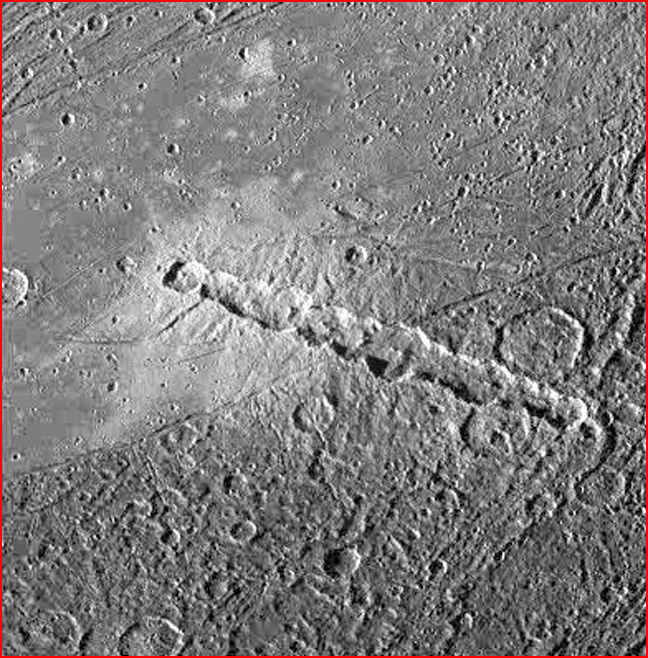
The networks of channels or rilles discovered on planetary surfaces constitute one of the great mysteries in planetary science. But they are also a crucial test of the electrical model because the model identifies the force creating most rilles as the same force that caused the dominant cratering patterns.
Look at the above image of Jupiter's moon Ganymede. Try to imagine an impacting body breaking up to form a neatly graded and spaced line of objects that might create this series of overlapping craters. Common sense tells us that the chance of this happening is virtually zero.
But crater chains are an observed effect of electric arcs passing over a cathode (negatively charged) surface, as discussed above (Craters in the Laboratory). With slight variations in the current or in surface composition, the arc may stop jumping from one crater to the next and cut a trench instead.
In other words, within the electric model, there is a full range of connections that must be explored between channels and craters. And yet mainstream science, while spending billions on space exploration, appears to have spent not a penny on exploring the power of electricity to create a wide range of enigmatic features observed in space.
In the picture of the Jovian moon Ganymede above, the craters overlap so closely that the distinction between "crater chain" and "straight rille" blurs. There are sections of this crater chain that could pass for a rille. When examined closely, the image also includes smaller rilles with scalloped sections that could pass for overlapping craters. Notice that the sizes of the craters are similar, with an increase toward the middle. From an Electric Universe point of view, this size gradation is a reflection of the initial increase in current as an arc becomes established, followed by a decrease as the arc quenches. In lightning strikes with multiple strokes, the middle strokes are usually the strongest.
Notice also that many of the craters retain their central peaks -- a common effect in craters created in the lab by electric discharge. The arc that carves a crater is a Birkeland current consisting of a pair of filaments that rotate around the current's axis. If the crater is large enough, the two filaments will not meet in the center, leaving a central spire intact.
Melting is another defining characteristic of electrical erosion. Although extensive melting is ascribed to impacts, impacts in fact produce little melting. The particles of rubble may be immersed in hot gases from the impact, but the heat dissipates too quickly for conduction to carry much of it into the particles. Electrical erosion, on the contrary, generates heat inside the eroded particles, in the manner of a heating element on an electric stove. A general expectation of the Electric Universe is that the floors of craters and rilles will show extensive glassification. Unfortunately, it can only be confirmed by on-site observations.
A final observation is that many craters appear to have their rims "pinched up," rather than "rolled over" or splattered as would be expected from debris thrown out by an impact. Many rilles, too, have "pinched up" dikes along their edges. This emphasizes the indication from missing debris that the erosional forces were directed upward.
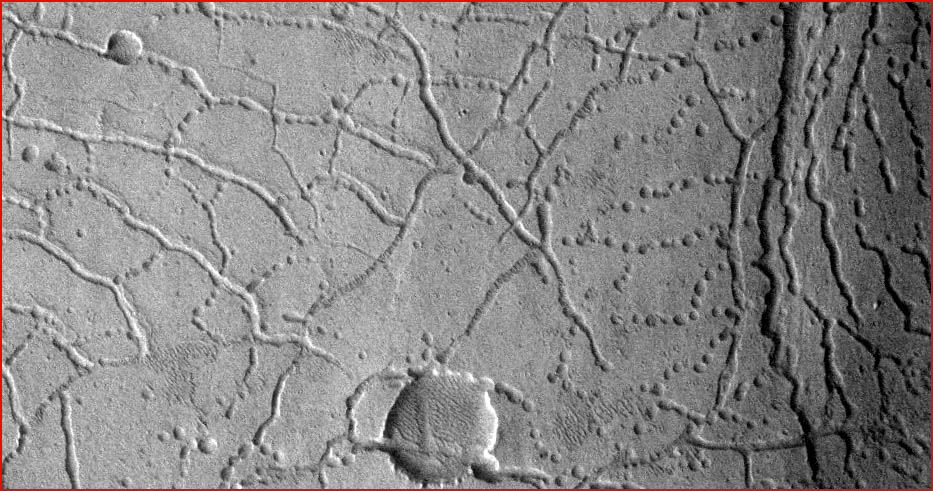
To see the relationship between crater formation and rilles, it's useful to observe the more extreme cases in which the standard explanation fails completely. Often, planetary scientists can only guess as to the force generating channels on Mars. Sometimes, they will "see" flowing liquid (water or lava), and other times they will "see" wind erosion, and still other times they will see cracks. In all of these cases, the visible link to craters will pose enigmas. Consider the extraordinary image above of the Martian surface, called Avernus Colles. The network of channels observed from space was certainly not caused by flowing liquid, and on the face of it, it is not surprising that planetary scientists identified the channels as cracks or "fractures." When viewed more closely, however, the "obvious" explanation evaporates. A small section of the region above shows unequivocally the relationship between a cratering process and the enigmatic channels. To appreciate the scope of the mystery, one should view the entire THEMIS image, available here.
Once the inseparable relationship of craters to channels is fully appreciated, planetary scientists will begin to see the essential connection of the same electric force to massive "surface etching" on Mars -- a process that has continued to baffle NASA investigators.
Subterranean Structure Beneath Craters

In examining the credibility of the electrical cratering hypothesis, space exploration will provide increasing opportunities to test the hypothesis against standard theory. In standard theory, a crater is born from a high-velocity impact, when the colliding object penetrates deeply into the soil, then explodes. The one certainty in the impact hypothesis is that the subsurface terrain will be massively disturbed.
In the electric model, however, subsurface material may be pulled upward toward the center of the crater to create a central bump or peak. That is the only disturbance that would be expected. Therefore, it was of great interest to the electrical theorists when Australian researcher Dave Smith noted an image returned to Earth from the Cassini probe of Saturn and its moons. A close-up of Saturn's moon Dione showed a surface exhibiting numerous craters, but also a sharply cut trench bisecting at least two craters. When Cassini captured the bissected craters from an angle, the subsurface layers were clearly exposed. It could be seen that no disturbances of the sort required by the impact hypothesis occurred in the event that gave birth to the crater.
Visible in the image is a layer of light material, and beneath that material, a layer of dark material. No disturbance can be seen in the boundaries between the two layers, though such disturbance would have been massive if in fact an impactor had created the depression.
The evidence cited above includes only several of thousands of craters most reasonably explained by the electric force. Of course, this is also typical of many of Earth's most famous craters: Richat Crater in the Saharan desert, whose uplifted terrain, circularity, concentric terraces, and layered sedimentary rock defy both the impact and volcanic theories of cratering; Aorounga Crater also in the Sahara, whose parallel grooves and intersecting ridges (which run through the surrounding landscape as well as the crater itself) have been described as "implausible" by geologists; Meteor Crater in Arizona, a 4,000 foot wide depression now regarded by science as an "impact" crater despite the UNDISTURBED rock beds below the crater; and Chicxulub Crater, the famous alleged site of the "asteroid" impact thought to have killed off the dinosaurs. Chicxulub is up to 300 km across, with multiple concentric rings, and the added mystery of Upper Cretaceous fossils found in UNDISTURBED layers -- fossils of the creatures that the impact was supposed to have wiped out.
Craters on bodies in space tell us a story that can revise our understanding of the Universe and our place in it. But this story cannot be seen or understood when vision is distorted by prejudice and assumption. If scientists can suspend these distorting assumptions, the story will become both obvious and revolutionary. The planets and moons in our Solar System are the war-torn remnants of a violent age. The force that battered them is the same force that gives exquisite structure to nebulae and galaxies, powers the Sun, and causes the spectacular displays of comets. That force is electricity.
______
For your best gateway to the Electric Universe, see Thunderbolts.info. And for a highly-acclaimed 60 minute video introduction to the Electric Universe, seeThunderbolts of the Gods on Google Video.